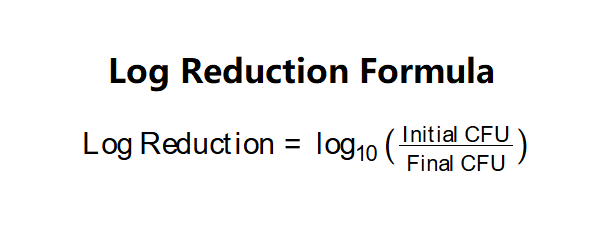1. What is the Log Reduction Calculator?
Definition: This calculator computes the log reduction and percentage reduction of microorganisms, typically used to evaluate the efficacy of disinfectants or sterilization processes.
Purpose: It is used in microbiology to quantify the effectiveness of a treatment in reducing microbial populations, such as bacteria or viruses, which is critical for infection control and public health.
2. How Does the Calculator Work?
The calculator uses the following formulas:
- \( \text{Log Reduction} = \log_{10} \left( \frac{\text{Initial CFU}}{\text{Final CFU}} \right) \)
- \( \text{Percentage Reduction} = 100 \cdot \frac{\text{Initial CFU} - \text{Final CFU}}{\text{Initial CFU}} \)
Where:
- \( \text{Initial CFU} \): Number of colony-forming units before treatment (CFU or CFU/mL, with multiplier);
- \( \text{Final CFU} \): Number of colony-forming units after treatment (CFU or CFU/mL, with multiplier).
Steps:
- Enter the initial CFU count with its multiplier and unit.
- Enter the final CFU count with its multiplier and unit (must match the initial unit).
- Apply the multipliers to the CFU counts.
- Calculate the log reduction using the logarithmic formula.
- Calculate the percentage reduction using the percentage formula.
- Display both results, formatted in scientific notation if the absolute value is less than 0.001, otherwise with 4 decimal places.
3. Importance of Log Reduction Calculation
Calculating log reduction is crucial for:
- Infection Control: Validates the effectiveness of disinfectants, ensuring they meet standards like the EPA's ≥6-log reduction for hospital-grade disinfection in ≤10 minutes [Ref web ID: 16].
- Public Health: Helps reduce the risk of disease outbreaks by ensuring adequate microbial reduction in water treatment, healthcare, and food safety [Ref web ID: 17].
- Regulatory Compliance: Ensures compliance with standards like those for Cryptosporidium removal in water systems, requiring a 2-log reduction for systems serving fewer than 10,000 people [Ref web ID: 17].
4. Using the Calculator
Example 1: Calculate the log reduction and percentage reduction for a disinfectant that reduces a bacterial population from 1 × 10⁶ CFU to 1 × 10³ CFU:
- Initial CFU: 1 × 10⁶ = 1,000,000;
- Final CFU: 1 × 10³ = 1,000;
- Log Reduction: \( \log_{10} \left( \frac{1,000,000}{1,000} \right) = \log_{10}(1,000) = 3 \);
- Percentage Reduction: \( 100 \cdot \frac{1,000,000 - 1,000}{1,000,000} = 99.9\% \);
- Result: Log Reduction = 3.0000, Percentage Reduction = 99.9000%.
Example 2: Calculate the log reduction and percentage reduction for a sterilization process that reduces a microbial population from 4.02 × 10⁶ CFU/mL to 1 × 10¹ CFU/mL:
- Initial CFU: 4.02 × 10⁶ = 4,020,000 CFU/mL;
- Final CFU: 1 × 10¹ = 10 CFU/mL;
- Log Reduction: \( \log_{10} \left( \frac{4,020,000}{10} \right) = \log_{10}(402,000) \approx 5.6042 \);
- Percentage Reduction: \( 100 \cdot \frac{4,020,000 - 10}{4,020,000} \approx 99.9998\% \);
- Result: Log Reduction = 5.6042, Percentage Reduction = 99.9998%.
5. Frequently Asked Questions (FAQ)
Q: What does a 5-log reduction mean?
A: A 5-log reduction means a 99.999% decrease in microorganisms, reducing the population to 0.001% of its initial count [Ref web ID: 1].
Q: Why use log reduction instead of percentage?
A: Log reduction simplifies large reductions into manageable numbers. For example, a 6-log reduction (99.9999%) is easier to interpret than a percentage with many decimal places, especially in microbiology [Ref web ID: 4].
Q: Can this calculator be used for water treatment?
A: Yes, it can evaluate microbial reduction in water treatment processes, such as ensuring a 4-log reduction of viruses as required by some groundwater regulations [Ref web ID: 17].
Log Reduction Calculator© - All Rights Reserved 2025
 Home
Home
 Back
Back
